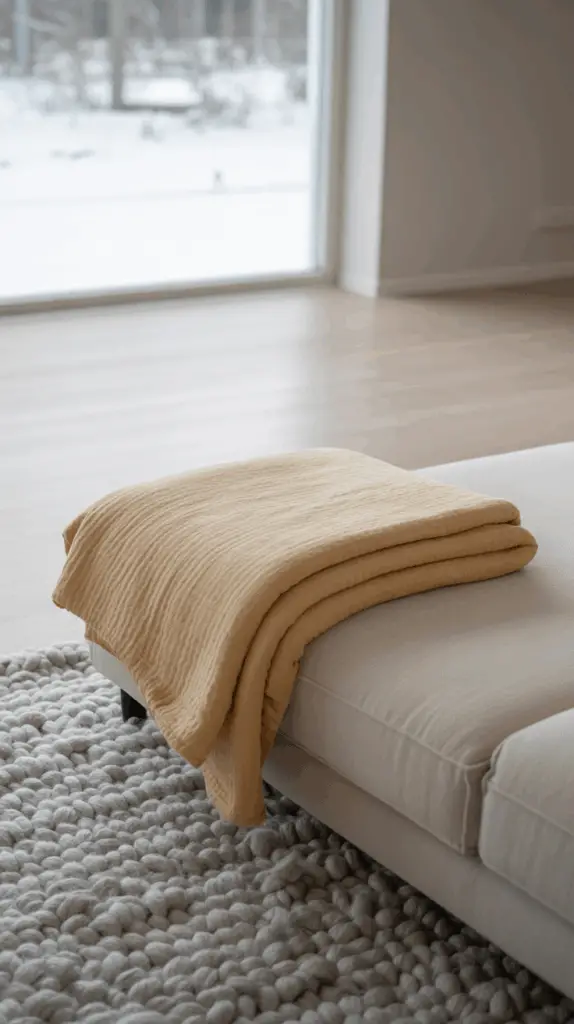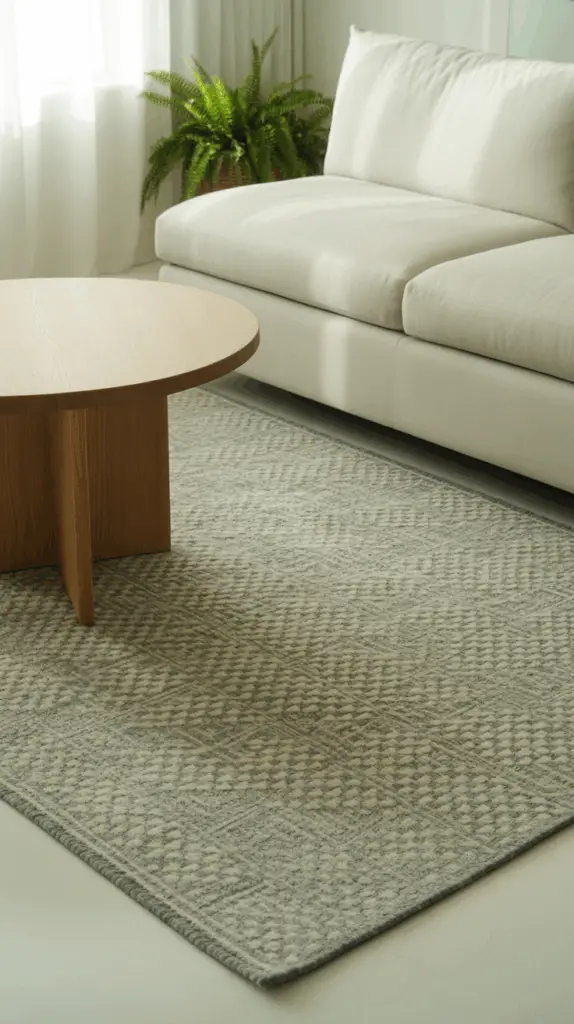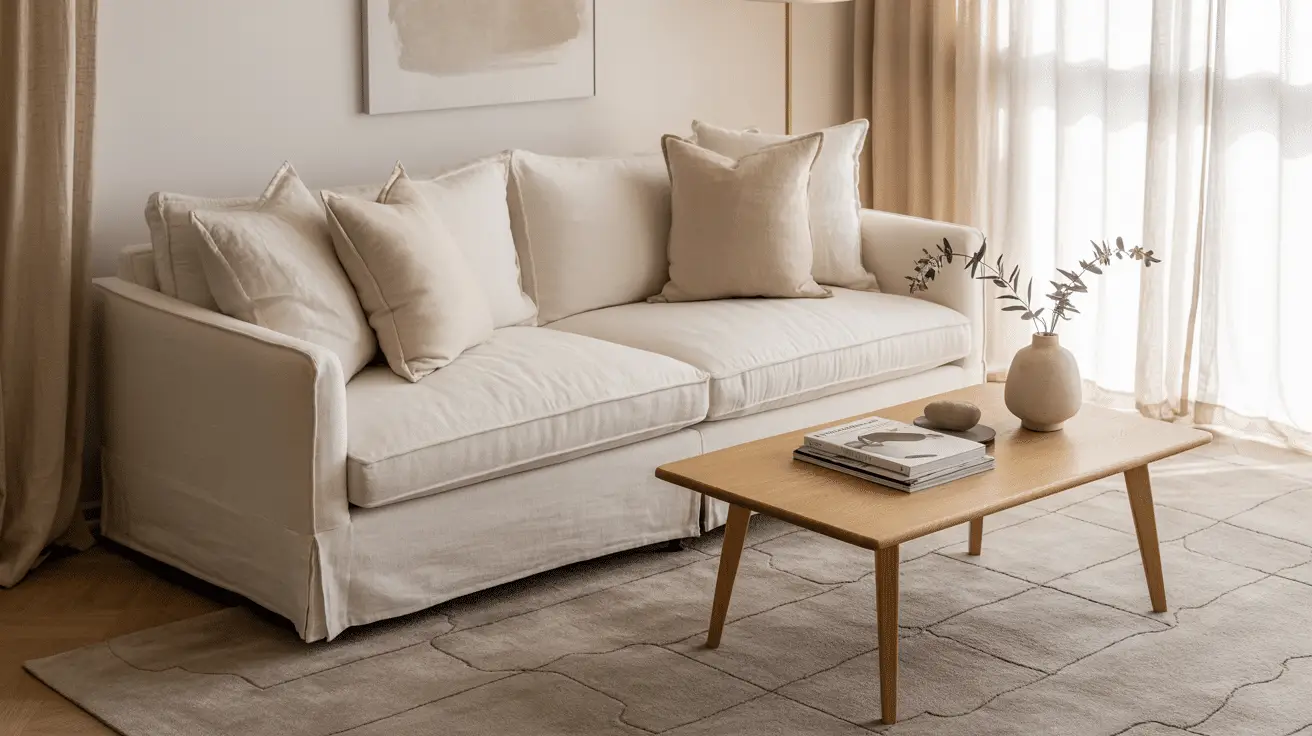Scandinavian Living Room Rug Ideas That Elevate Minimalist Comfort
Table of Contents
Bringing Hygge Home: Why Scandinavian Rugs Are the Key to Cozy Minimalism
Minimalism doesn’t have to mean cold. In fact, the Scandinavian approach to design proves the opposite—by pairing clean lines with natural textures, functionality with warmth, and simplicity with soul. And when it comes to creating this harmony in the living room, the rug is often the silent hero.
Rugs in Scandinavian interiors do more than define a space—they invite comfort, quiet the room acoustically, and ground the furniture in calm, natural tones. According to Google Trends and design platforms like Pinterest, searches for “Scandinavian living room rugs” have consistently climbed, showing a rising desire for spaces that feel both minimal and lived-in.
So how do you pick the right rug for your minimalist Nordic-inspired space? From color and material to shape and layering, there’s more to Scandinavian rug styling than meets the eye. In this guide, we’ll walk you through the essentials of choosing the perfect rug for your living room, inspired by the timeless principles of Scandinavian design: simplicity, functionality, and hygge—Denmark’s famed concept of cozy contentment.
Whether you’re designing from scratch or updating an existing room, these ideas will help you select a rug that transforms your space from simply clean to deeply comforting.
Neutral Color Palettes that Embrace Light and Calm
Scandinavian design revolves around soft, neutral tones that reflect the region’s natural light and serene landscapes. When it comes to choosing a rug, this typically means leaning into whites, greys, beiges, soft browns, and muted earthy shades.
These tones do more than just “go with everything”—they serve as a visual pause in a space, anchoring your furniture while allowing your living room to breathe. A pale wool rug under a soft grey sofa, or a sand-colored cotton weave on warm wood flooring, feels instantly harmonious and effortlessly elegant.
Layering whites and light tones also plays a role in the region’s long, dark winters, reflecting what little natural light is available to keep the room feeling airy. But a neutral rug doesn’t have to mean boring—look for subtle patterns, heathered yarns, or mixed textures to add depth without disrupting the calm.
Table: Scandinavian-Neutral Rug Shades and Their Effects
| Rug Color | Best Pairings | Visual Effect |
| Off-white | Oak wood, linen, pale grey textiles | Brightens and enlarges the room |
| Soft grey | Charcoal, muted pastels, white walls | Adds modern softness |
| Beige | Rattan, ivory, black accents | Feels warm, timeless, grounded |
| Greige | Concrete floors, warm wood | Balances cool and warm palettes |
| Light taupe | Brass finishes, tan leather, plants | Natural, cozy, highly adaptable |
Natural Fibers and Materials That Add Understated Texture
In Scandinavian design, texture plays a quiet but powerful role. Natural fiber rugs like wool, jute, cotton, or even a flatwoven blend bring a soft, grounding tactility to a space—without overpowering its clean aesthetic.
Wool rugs are a Nordic classic, loved for their insulating properties, softness underfoot, and longevity. They add instant hygge, especially in colder months. For a more casual or budget-friendly option, cotton rugs offer a lighter touch, ideal for layering or smaller rooms. Jute and sisal bring in a rustic, earthy texture that pairs beautifully with pale wood and ceramic accents.
Stick to simple weaves—flatwoven, looped pile, or low-pile textures that feel intentional. Avoid overly plush or high-shag rugs, which can detract from the refined simplicity of minimalist interiors.
Table: Rug Material Guide for Scandinavian Interiors
| Material | Feel Underfoot | Ideal Use | Style Benefit |
| Wool | Soft, plush | Main rug in lounge area | Cozy, classic, long-lasting |
| Jute | Firm, textured | Accent or underlayer rug | Natural, earthy tone |
| Cotton | Soft, lightweight | Small to medium living rooms | Casual, easy to clean |
| Flatweave | Smooth, durable | High-traffic or layered zones | Sleek, structured appeal |
| Sisal | Coarse, rustic | Decorative use, low-traffic area | Strong texture, natural finish |

Geometric Patterns That Echo Nordic Simplicity
While Scandinavian design tends to avoid excess, subtle geometric patterns are often used in rugs to add visual interest without clutter. These patterns—often inspired by nature, symmetry, or folk motifs—create movement and texture while staying in harmony with the room’s minimal feel.
Think soft diamond shapes, broken stripes, linear grid patterns, or tonal variations created through weave structure rather than bold color. A neutral rug with a quiet geometric pattern can become the centerpiece of your space without disrupting its calm.
Avoid overly busy or contrasting patterns that feel too loud. Instead, opt for designs that blend into the color scheme, such as ivory on beige or grey on white. These offer dimension without distraction, making your living room feel dynamic yet grounded.
Table: Popular Geometric Rug Patterns in Scandinavian Design
| Pattern Style | Best Color Combination | Ideal Setting |
| Diamond Weave | Ivory on warm grey | Adds movement under simple furniture |
| Minimalist Stripes | Tone-on-tone neutral shades | Elongates the space |
| Grid Linework | Soft black on cream | Sharpens modern lines |
| Crosshatch | Beige and taupe | Blends into layered neutrals |
| Nature-Inspired | Organic curves in tan/grey | Softens angular layouts |

Layering Rugs for Added Depth and Warmth
Layering rugs is an easy way to bring depth, texture, and warmth to your living room without overwhelming a minimalist layout. This technique, increasingly popular in Scandinavian interiors, helps define zones, frame furniture, and add seasonal flexibility to your design.
Start with a large base rug in a flat, neutral tone—like beige, greige, or cream. Then add a smaller rug on top with a soft geometric pattern or tactile material like wool or faux sheepskin. This adds comfort and visual interest without crowding the space.
Layering also allows you to adjust with the seasons. In warmer months, a jute or cotton base may be all you need. In winter, simply add a warm wool accent rug or sheepskin to create instant coziness.
Make sure your rugs share similar tones or textures to keep the look cohesive. Align them purposefully—either centered or offset to one side—to avoid a cluttered feel.
Table: Rug Layering Combinations for Scandinavian Comfort
| Base Rug (Neutral) | Top Rug (Accent) | Style Outcome |
| Flat jute rug | Wool Moroccan-style rug | Textural contrast, cozy upgrade |
| Light cotton weave | Faux sheepskin throw rug | Soft layering, hygge charm |
| Grey wool rug | Beige striped runner | Clean lines, directional focus |
| Off-white sisal | Diamond-pattern flatweave | Nordic chic, low-profile depth |
Size and Placement Tips for Effortless Flow
Choosing the right rug size and placing it thoughtfully is key to achieving that clean, airy Scandinavian look. Too small, and your rug floats awkwardly. Too large, and it can overwhelm the furniture.
In most Scandinavian living rooms, the ideal rug is large enough to sit beneath all main seating furniture—sofa, chairs, and coffee table. If space is tighter, aim to have at least the front legs of all furniture pieces resting on the rug to visually tie them together.
The rug should frame your layout, not fight it. Leave consistent space between the rug and the walls (ideally 8 to 18 inches). And always align it with the longest wall or main sightline to help elongate the room and guide the eye.
Table: Rug Sizing Rules for Living Room Layouts
| Room Size | Ideal Rug Dimensions | Placement Tips |
| Small (10’x10′) | 5’x8′ or 6’x9′ | Front legs on rug, coffee table centered |
| Medium (12’x14′) | 8’x10′ | All furniture legs on rug |
| Large (14’x18′) | 9’x12′ or larger | Generous border, full framing |
| Open Concept | Use rugs to define seating | Visual separation without walls |
Cozy Seasonal Rug Swaps to Refresh Your Look
Scandinavian design embraces the rhythm of nature—so refreshing your rugs with the seasons can be a beautiful, subtle way to keep your space feeling current and cozy.
In spring and summer, lean into light, breathable materials like cotton or flatwoven blends in pale hues. These rugs keep the room feeling airy and fresh, especially when paired with linen or rattan furniture.
Come fall and winter, swap in wool rugs, faux fur, or high-texture blends to add warmth and softness underfoot. Layering becomes especially effective here, allowing you to keep your base rug while adding a seasonal top layer for instant transformation.
Not only does this keep your space adaptable and interesting, but it also reflects the Scandinavian appreciation for functional beauty—a home that changes with its inhabitants and the world outside.
Table: Seasonal Rug Rotation Ideas
| Season | Recommended Rug Type | Styling Notes |
| Spring | Flat cotton weave | Light colors, breezy textures |
| Summer | Natural fiber like jute | Layer with cushions for softness |
| Autumn | Wool with soft patterns | Earth tones, cozy layers |
| Winter | Faux sheepskin, deep pile | Adds warmth, hygge aesthetic |
Conclusion: The Art of Quiet Comfort Through Scandinavian Rugs
A Scandinavian living room isn’t just about visual appeal—it’s about how the space makes you feel. And a well-chosen rug has the quiet power to ground your room in comfort, calm, and intention.
From natural textures and neutral tones to thoughtful placement and subtle layering, the Scandinavian rug isn’t just décor—it’s an experience underfoot. It reflects light, softens sound, and defines the atmosphere of the entire space.
Whether you prefer airy cottons or plush wool, geometric patterns or simple solids, your rug should echo the values of Scandinavian design: minimalism with meaning, beauty with function, and warmth that welcomes.

